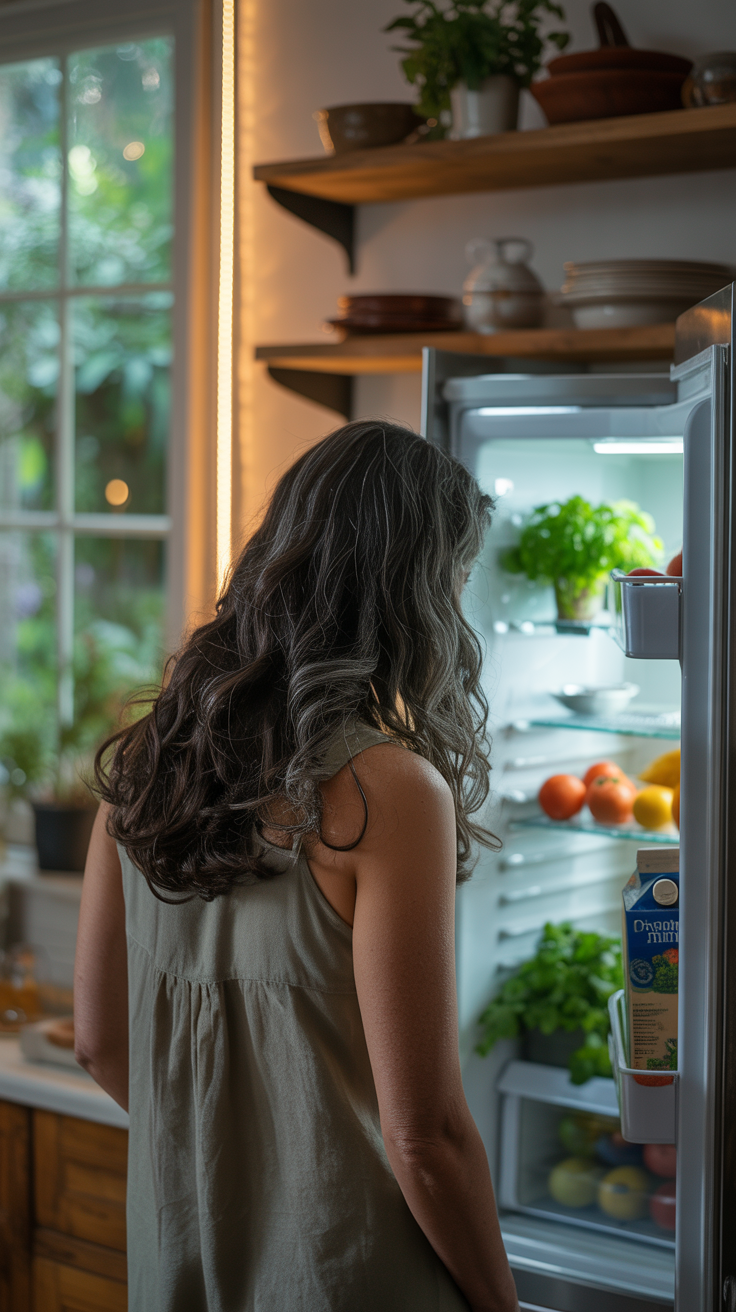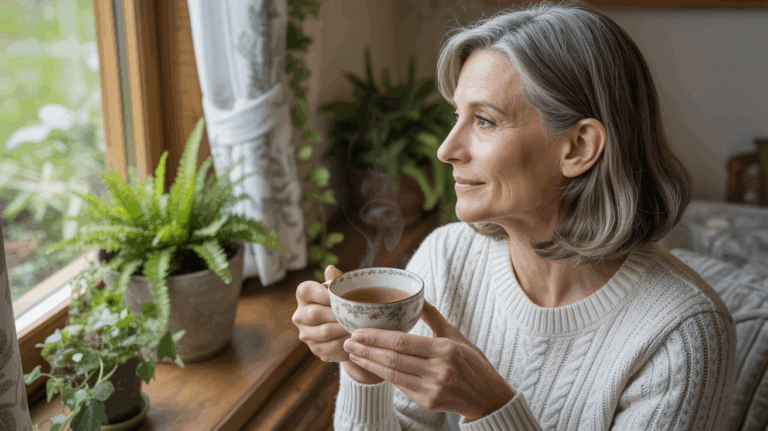Is Intuitive Eating Right for Midlife Women?
For many of us, diet culture has been whispering in our ears for decades. It teaches us to distrust our own bodies. It encourages us to count calories instead of listening to hunger. It prompts us to measure self-worth in pounds or pant sizes.
Over time, those outside voices can drown out the natural cues we were born with — hunger, fullness, and satisfaction.
I never thought I’d get tangled up in it. I was always thin, even after having three babies. For most of my life, I ate when I was hungry. I stopped when I was satisfied. I didn’t think too much about food, other than cooking and taking care of my family.
That all changed when health issues hit in my late thirties. Suddenly my body shifted. I gained weight in a short period of time and felt exhausted, among other symptoms. My doctor thought it was Chronic Fatigue Syndrome. But that story is for a different blog post.
For the first time I thought, maybe I should try a diet.

That first diet was the beginning of a struggle I never expected. I stopped listening to my body. I began relying on rules, apps, and meal plans. They told me when, what, and how much to eat.
My hunger cues got quiet, my fullness signals felt confusing, and eating became less about nourishment and more about numbers. Over the years I cycled through diet after diet — including long stretches of Keto and even Carnivore.
Each diet promised results. And I did see results — for a while. But it never lasted. It wasn’t sustainable. It didn’t bring me peace.
Every plan was just another set of rules. Rules that came from outside my own body. Rules that made me ignore my hunger and fullness signals.
And of course, there were always people ready to sell me the “solution.” Quick fixes. Magic answers.
If I slipped up? The shame came right along with it.
If you’ve been on the diet culture roller coaster, I’m sure you can relate to this.
Finally, I had enough. I let go of diet culture. I chose to listen to my own body. No “diet plan” could ever know when I needed food. Or when I needed rest. Or anything else.
God created us with built-in signals. A kind of inner navigation system.
I remembered how well it worked when I actually paid attention. That was the start of my Intuitive Eating journey.
I’m just at the beginning, but already I notice a difference. My energy is better. And maybe best of all — when I’m not hungry, the constant “worry” about food is gone.
That’s why I want to explore the question: Is intuitive eating right for midlife women?
Let’s take a look at what the research says. Learning to trust your body again might be exactly what this season of life calls for.
What Is Intuitive Eating (and Why It Matters in Midlife)
At its core, intuitive eating is simply learning to pay attention to the signals God built into our bodies. We were designed with hunger and fullness cues for a reason — to guide us toward nourishment and balance.
When we ignore those signals or let diet culture override them, we lose touch with that natural rhythm.
Mindful eating is one way to reconnect. It’s about slowing down. Notice your food. Pay attention to how it makes you feel — physically, and emotionally.
Mindful eating invites you to pause. Pray if you’d like. Truly experience the meal in front of you.
But eating isn’t always about fuel. In real life, we often turn to food for other reasons:
- Stress: reaching for something quick when emotions feel heavy.
- Boredom: snacking when we’re restless, not hungry.
- Celebration: gathering with family and friends around the table.
- Anger or sadness: using food as comfort or distraction.
None of these make you a failure — they just show that food often carries meaning beyond nutrition. The key is learning to notice why you’re eating and gently asking: Am I truly hungry? Or am I looking for comfort, distraction, or connection?

What Intuitive Eating Isn’t
It’s not a free-for-all or “eat whatever you want, whenever you want.” Although no foods are forbidden the focus is more:
- Tuning in to your body’s cues.
- Letting go of guilt and shame around food.
- Building trust with yourself again.
For midlife women, this can be a profound shift — moving from decades of dieting into a gentler, more sustainable approach.
Why Midlife Women Struggle With Diet Culture
Perimenopause and Body Changes
Hormonal changes in perimenopause and menopause can affect weight distribution, energy, and appetite. Many women find themselves gaining weight in new places or struggling to feel at home in their changing bodies.
Years of Dieting and Disconnection
If you’ve spent years counting points, cutting carbs, or fasting, your hunger and fullness cues likely feel fuzzy. Diet culture teaches you to ignore your body and rely on outside “rules.”
Emotional Toll of Dieting
Dieting often leaves women feeling like failures when the weight comes back. Research shows diets rarely work long-term. This cycle is frustrating in midlife, when you’re already navigating physical and emotional changes.
What the Research Says About Intuitive Eating in Midlife
Body Composition Benefits
A 2023 study found that midlife women with higher intuitive eating scores had lower total body fat. They also had less abdominal fat. That’s significant, since abdominal fat often increases in menopause.
What the Research Says About Midlife Women and Intuitive Eating
I’ve linked some studies below. You can check them out for yourself if you’d like.
The research is clear. Women who practice Intuitive Eating feel better. They feel calmer around food. They feel more at peace with their bodies. They have more energy.
Why? Because they are listening to their own hunger and fullness cues. Not a diet. Not an app. Not a set of rules.
When you tune back in to the way your body was designed, something shifts. Food is no longer the enemy. It becomes simple again.
And here’s the best part — women who eat this way are happier.
-
- Owens et al. (2023): Higher intuitive eating scores correlated with lower total body fat and lower abdominal fat in 116 midlife women. ourarchive.otago.ac.nz+4ScienceDirect+4MDPI+4The SunPubMed+4PubMed+4ScienceDirect+4
- Owens’ dissertation (2023): IE was linked to lower abdominal and total fat and fewer depressive symptoms; and it may mediate the relationship between stress and adiposity. ScienceDirect+1
- Barraclough et al. (2019): A qualitative study showing how mid‑age women learn to eat intuitively and how it shifts lifelong dieting patterns. DigitalCommons@PCOM+15Wikipedia+15journalofhappinessandhealth.com+15
- Martin (2023) at Otago: Research focuses on how mid-age women move toward IE by exploring body cues, permission to eat, and eating for physical rather than emotional reasons. University of Otago+2Frontiers+2
3. Beyond Weight: Mental Health & Body Image
- Carrard (2021): In older women, higher intuitive eating linked with lower disordered eating and better body image. Research Protocols+15ScienceDirect+15PubMed+15
- Irmischer et al. (2024): Among middle-aged adults (36–65), higher self-compassion predicted better intuitive eating habits, promoting wellbeing. journalofhappinessandhealth.com
- Şenol et al. (2025): In a 12-week IE intervention, participants showed improved body image and healthier eating attitudes, even with no significant change in weight. MDPI
- Açık et al. (2025): IE and mindful eating were indirectly linked to better mental health markers (e.g., reduced psychological distress) through improved eating and lifestyle habits. Frontiers
Mental Health and Body Image
Other studies show intuitive eating is linked to:
- Fewer disordered eating behaviors.
- Better body image.
- Lower levels of depression and anxiety.
One intervention study found women who practiced intuitive eating for 12 weeks improved their body image. Their eating attitudes also improved. This happened even without dramatic weight changes.
Stress and Self-Compassion
Research also suggests that self-compassion is tied to better intuitive eating habits, especially in midlife. Learning to be gentle with yourself can be the key to reconnecting with your body cues.
Practical Ways to Try Intuitive Eating in Midlife
Notice Hunger and Fullness
Note how hungry you feel on a scale of 1–10. Choose your favorite flavors on your plate. Eat those first. If you get full, the rest is easy to leave behind.
Eat slowly and without distractions, if possible. Notice how the best bites are when you’re hungry! As your hunger subsides, the food won’t taste as good.
Eat until you feel calm and full. Don’t eat until you’re overstuffed.
Afterward, note how satisfied you are. No judgment, just awareness.
It takes time to relearn how to listen to your own cues. Don’t give up. It will get easier if you keep at it!
Ditch the Food Rules
Challenge “good” vs. “bad” food thinking. Allow yourself to eat a variety of foods and pay attention to how they make you feel.
Forget the “all or nothing” diet culture messaging. There are no failures or “off the diet” events. Only learning experiences about what food feels nourishing, and hunger and fullness cues.
Add Gentle Movement
Intuitive Eating is about food. But it is deeply connected to intuitive wellness. It’s about reconnecting with your body. Walking, rebounding, gardening, stretching, or Tai Chi can help you feel more in tune with your physical body.
Moments of stillness like journaling, praying, or just resting can help you feel mentally connected. They can also help you feel spiritually connected with your wellness.
Focus on Satisfaction
Ask yourself: What would satisfy me right now? Sometimes it’s a salad, sometimes it’s a slice of cake. Satisfaction reduces overeating because your body feels truly cared for.
It’s normal to want all of the foods that were off limits before. Focus on your hunger and fullness cues and this will subside.
Practice Self-Compassion
You will have moments when you overeat, eat emotionally, or feel frustrated. Instead of judgment, offer yourself kindness. This is a journey, not a quick fix.

My Experience So Far
I’m still at the beginning of this journey, but the difference is real. My energy is better. Food is no longer a constant mental battle. And for the first time in years, I feel like I’m building trust with my body instead of fighting it.
Intuitive Eating is not about chasing a number on the scale. It’s about reclaiming peace with food. It also involves learning to honor your body in midlife.
Final Thoughts: Is Intuitive Eating Right for You?
If you’re tired of diets that leave you exhausted, hungry, and discouraged, consider intuitive eating. It might be the gentle option you’ve been searching for. The science shows it supports both body and mind, especially for women navigating the shifts of perimenopause and beyond.
It’s not about quick fixes. It’s about rebuilding trust with yourself — one bite, one meal, one choice at a time.
Find Clarity and Confidence: Stillness Before the Shift Method
Feeling stuck, overwhelmed, or unsure of your next chapter? 🌿 The Stillness Before the Shift Method is a gentle 90-day practice. It is designed for midlife women who are ready to go deeper and get out of overwhelm.
This method helps you reconnect and make aligned decisions with confidence. Discover simple practices for clarity, joy, and renewed energy—without the hustle.
I’ve been there and I’m with you every step of the way!






